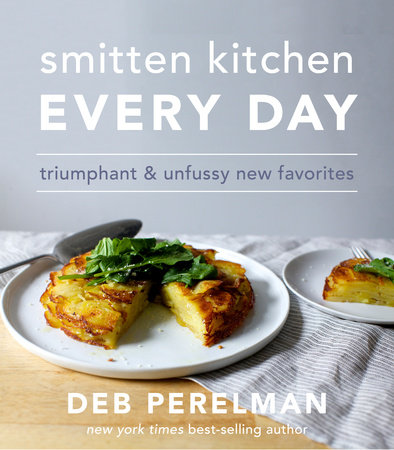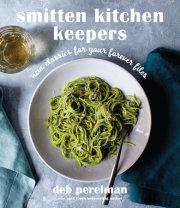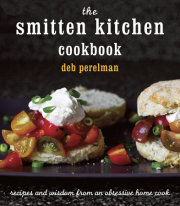against drudgery
(or, hooray for breakfast, dinner, and cake)
One of the delights of life is eating with friends; second to that is talking about eating. And, for an unsurpassed double whammy, there is talking about eating while you are eating with friends. People who like to cook like to talk about food. Plain old cooks (as opposed to geniuses in fancy restaurants) tend to be friendly. After all, without one cook giving another cook a tip or two, human life might have died out a long time ago. —laurie colwin,
Home CookingWe home cooks have never gathered in force to speak out in defense of home cooking. So the image of cookery as drudgery lives on. —marion cunningham,
Lost RecipesThis isn’t the cookbook I had expected to write.
When The Smitten Kitchen Cookbook headed to the printer in 2012, we were a family of three. Our two-year-old was eating table food, but in a dabbling way. Mostly, I cooked the food that I was excited to eat and little about having a kid changed how I went about it. In the years since, we’ve added another delicious little human to our family and while most people will tell you that going from 0 kids to 1 is the big adjustment, in the kitchen, the shift from 1 to 2 was more dramatic. All of a sudden, it wasn’t just us plus an extra half-portion stripped of offending chile peppers or with some couscous on the side to bait a suspicious toddler to the table. Quickly, half our family (ahem, the noisier half) needed square meals at predictable times and I, well . . . I began to understand why not everyone jumps with joy when it’s time to make dinner.
On any given night, most of us have countless really excellent reasons not to cook—be it picky kids, spouses, or roommates, or the extinction of a 9-to-5 workday that might actually get you home in time to assemble dinner for yourself, your friends, or your family. Even the people who are ostensibly cheering for you to cook can do more harm than good, be they restaurant chefs who forget you may not have a line of prep cooks at your disposal, recipe writers who alienate the budget-conscious by insisting on the “best” olive oil, or home-cooking advocates who tell you the very best thing you can do for your health/your children’s IQ/the economy/environment/nothing short of this earth (oh, the pressure!) is cook dinner every night—people who have clearly not spent a lot of time in the chaos of most households at Hangry O’Clock. (Roughly, 30 minutes after pizza would have been there already, at least around here.)
I began to wonder if it was time to write about the realities and practicalities of cooking. You know:
•How to Keep the Joy in Cooking
•42-ish Minute Meals (But You’ll Have to Rush)
•Things to Make with Broccoli and/or Sweet Potatoes, the Only Vegetables Everyone Agrees on This Week
•Just Kidding, the Baby Ate Blueberries for Dinner Again
There was only one problem: I didn’t want to write this book at all. And so I did not. I continued sharing new recipes a couple times a week on my website, Smitten Kitchen. I launched a newsletter. I worked with people to usher the technology behind my site into its second decade of web life. I started working with the Food Network on a digital series. I spent a lot of time around the table with friends and family and couldn’t help but notice that what was regularly taking place—telling stories, workshopping silly armchair philosophies, cracking up over the baby’s antics—barely resembled the compromised, plodding hypotheses I’d set out about cooking when life gets busier.
What I have always loved about cooking is the way a happy discovery—a new way to meatball, a four-ingredient farro that has caused more than 800 comment section exclamation points, cookies that look like clouds and taste like pink lemonade, crunchy spaghetti with crispy eggs, a birthday cake you can make from scratch in just over an hour (yes really) or maybe even four of them—has the power to completely change the course of a day.
I like the way that when you make something new and awesome the first thing you want to do is tell another friend about it so they can make it, too. I like the way following a recipe to the letter can feel like handing the reins over after a long day of having to make all the decisions, but also that pulling off a good meal when you least expected is the fastest way to feel triumphant, even if your day left you short of opportunities to. I like the way that when you sublimate your wanderlust in a dish—a cacio e pepe addiction picked up in Rome or a Thai salad with crispy shallots, lime, and fish sauce—it becomes a gateway, or an escape hatch, to so much more than dinner. I like the way that when you cook at home, you don’t actually have to compromise a thing; you get to make exactly what you want, exactly the way you want it, and then you get to invite all your favorite people over to pass the dish around. I like the way a great meal makes grouchy people ungrouchy or a thankless day filled with thankless stuff into a hilarious one. And I like the way the prospect of a fudgy one-bowl chocolate cake with a raft of chocolate frosting one hour from now might make us cancel our other plans.
And the thing is, people—that is, you, the people who have come along for all or part of Smitten Kitchen’s decade-plus story—had been trying to tell me this the whole time.
The stories in the comments and in my inbox are as much about the cooking as they are about the life around it—the delight from the surprise of a good meal, the person who thought they hated broccoli or Brussels sprouts finding that with the right preparation, they adore both, or finding, on a morning you think there’s no reason to cook, a new pancake recipe that you’re too curious not to make. This doesn’t mean that these dishes aren’t practical, that they cannot fit into a busy life, that they cannot accommodate picky eaters and grocery stores with limited imagination, it simply means that they don’t do that before—they don’t prioritize that over—making food that we are really, really excited to eat.
This book is how—forgive me—I got my groove back.
These recipes don’t just fit into our lives, they make us happy.
Happiness is great big bowls of beans that we dip into like nachos.
It’s my kids’ beloved roasted sweet potatoes given the dry-rub barbecue treatment, slaw and all.
It’s the famous chopped liver you get in a windowless basement restaurant on Christie Street that’s like a Bar Mitzvah that never ends (in a good way).
It’s a crunchy three-cheese pasta bake that tastes better with Brussels sprouts (yes, Brussels sprouts) than without.
It’s giant white beans cooked to the tune of baked ziti, bronzed melty lid and all.
It’s the hopelessly unapologetically inauthentic kale Caesar we make almost every week of the year.
It’s the English-muffin meets-Jewish-deli-rye-bread recipe I promised to a library full of people a book tour ago.
It’s a modern matzo ball soup and the beef bulgogi tacos I fell in love with at the Jersey shore.
It’s a whole-grain bread for people who don’t like to knead or time things, a bread that works on your schedule and not vice versa.
And such a great big noisy fuss over cake (and cookies and pies and Popsicles).
The jam-filled, sprinkle-rolled butter cookies I made at the bakery where I worked in high school.
The gooey oat and chocolate cookie bars that will win bake sales.
The strawberry tart that the stray friend we picked up at a party sixteen years tago coached me through over Skype from Germany.
The chocolate icebox cake to end all icebox cakes, with peanut butter too.
The crumb cake with impeccable priorities—that is, more crumbs than cake—and a very familiar name.
A sticky toffee pudding, but breakfast-style.
The blueberry muffins I made fifty ways before finding my forever formula.
And an accidental two-ingredient granola.
So while this isn’t the cookbook I expected to write, I like the one that’s emerged much more—a celebration of breakfast, dinner, cake, and everything in between, and maybe a bit of resistance, too: against the idea that cooking must be an obstacle to overcome or and that the food we most want to eat cannot also be practical. This book is all of my new favorite things to cook, and I hope you’ll find a few worthy of your Repeat Forever files, too.
deli rye english muffinsyield: 12 miniature (21/4-inch) or 8 standard-sized (31/2-to-33/4-inch) muffins
My favorite thing about this recipe is where it started, which, specifically, was in front of a library full of people in St. Louis while I was on a book tour. Someone asked me how I came up with recipes, and I’m sorry if it disappoints you to learn this, but I’ve never been good on my feet and was as fumbling and inarticulate as ever: “Uh, sometimes they just come to me? Or I’ll just get an idea when I’m on the crosstown bus and . . .” It was pretty bad, but since there was no one to rescue me, I just blathered along. “. . . Like, this morning, I was thinking how cool it would be if you could make an English muffin that tasted like rye bread, because they’re my two favorite kinds of toast to go with eggs,” and someone said, “You should! Now you can start your second book!”
So, as fated—eh, 2.5 years and one kid later—I began here. I learned a few things along the way. English-muffin recipes are divided into two camps: those that require pastry rings to hold the batter in shape, and those that use a thicker dough but allow you to free-form them. The first category make for great nooks and crannies, but are unquestionably a pest to maneuver. The second category have some nooks and a few crannies but don’t require any specialty-store purchases. To get the results of the peskier method without the hassle, I found you had to use a softer dough.
And then, once you’ve made English muffins that taste like a good deli rye bread, what do you do with them? Toasting them with sweet butter is always my first choice. They’re also excellent with a heap of scrambled eggs or a crispy fried one, maybe with a little hash underneath. And they’re good for any kind of sandwich you’d normally put on rye.
21/4 teaspoons (from a 7-gram or 1/4-ounce packet) active dry yeast
1/4 cup (60 ml) lukewarm water
3/4 cup (175 ml) milk or buttermilk
2 tablespoons (30 grams) unsalted butter, plus more for bowl
1 tablespoon (15 grams) granulated sugar
2/3 cup (80 grams) dark rye flour
11/3 cups (175 grams) all-purpose or bread flour, plus more for surface
11/2 teaspoons coarse or kosher salt
2 teaspoons (5 grams) whole or ground caraway seeds
Oil, for greasing bowl and coating skillet
Cornmeal, polenta, or semolina, for sprinkling
Combine the yeast and water in the bowl of a stand mixer fitted with a dough hook. Let rest 5 minutes; the yeast should dissolve and look slightly foamy. Gently warm the buttermilk, butter, and sugar to lukewarm (not hot), and add it to the yeast mixture, followed by the flours, salt, and caraway. Use the dough hook to combine until a shaggy, uneven dough forms; then let the hook knead it down on the lowest speed for 5 minutes, until the dough is stretchy and cohesive. Butter or oil a large bowl (or do as I do and remove the dough long enough to oil the mixing bowl, then return the dough to it), and let it proof at room temperature, covered with a dishcloth or plastic, for 1 hour. (That’s it!)
Lightly spray a large baking sheet with oil, then generously sprinkle it with cornmeal. Lightly flour your counter, turn the dough out onto it, flour the top, and gently deflate it with your hands. Divide the dough into pieces; twelve pieces for minis, eight for standard muffins. Roll them gently into balls, and place on the cornmealed baking sheet, pressing gently to flatten them into discs (about 3/4‑inch diameter). Spray the tops lightly with oil, and sprinkle them with cornmeal, too. Cover loosely, and proof at room temperature for 30 minutes more or up to 3 days in the fridge. If chilled, let them warm up for 30 minutes at room temperature before cooking.
Heat oven to 250 degrees.
Let a cast-iron skillet warm over the lowest heat for 5 to 7 minutes, then lightly coat the inside with neutral cooking oil for insurance against sticking, but not enough that the muffins will fry. Dust off the excess cornmeal from the muffins. Let the bottom of each muffin brown slowly and very gently in pan, about 5 minutes. (If yours are taking longer, you can bump the heat to medium-low.) Flip them, and cook for another 4 to 5 minutes. You can flip back and forth again if needed.
Shake the excess cornmeal off the baking sheet, and transfer pan-toasted muffins to oven. Bake for 20 to 25 minutes until sides are firm to the touch. Cool to almost room temperature, then fork-split.
Copyright © 2017 by Deb Perelman. All rights reserved. No part of this excerpt may be reproduced or reprinted without permission in writing from the publisher.


















